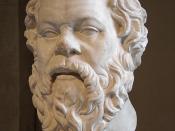In book 7 Plato questions the validity of our perceptions by using the analogy of the cave attempts to describe human nature in both of its states, the educated and the uneducated. Uneducated people are like prisoners chained in a dark cave. Socrates then asks his audience to imagine a cave with prisoners in it. The cave has a long entrance and there is a fire burning above which gives them light. The glare of light from the outside world would cause pain to the prisoner's eyes and he would suffer. The prisoners are kept underground and forced to look upon the shadows of "real" objects. Kept there since birth, they have taken the shadows to be reality, and with their necks chained so that they cannot look around, they have assumed that these shadows of reality are reality itself.
The prisoners have been chained since childhood, and can only look from side to side.
Between the fire and the prisoners, higher than the prisoners, there is a road with a low wall built alongside it, similar to the screen set in front of a puppet master. People, and animals, often walk along the road, sometimes talking and other times silent.
The cave is a metaphor for human existence. The people in the cave accept the shadows on the cave wall as reality because this is all that they have experienced. The echoes they hear are assumed by them to be real for the same reason. Plato is trying to illustrate that people know little truth about the reality of the world. The philosopher is the escaped person who goes into the light and can see the true reality of the world around them. Plato argues that it is the duty of the philosopher to inform the people in the...


